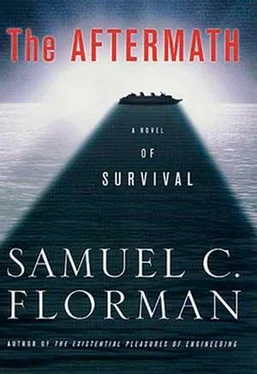Samuel Florman - The Aftermath
Здесь есть возможность читать онлайн «Samuel Florman - The Aftermath» весь текст электронной книги совершенно бесплатно (целиком полную версию без сокращений). В некоторых случаях можно слушать аудио, скачать через торрент в формате fb2 и присутствует краткое содержание. Город: New York, Год выпуска: 2001, ISBN: 2001, Издательство: Thomas Dunne books, Жанр: sf_postapocalyptic, на английском языке. Описание произведения, (предисловие) а так же отзывы посетителей доступны на портале библиотеки ЛибКат.
- Название:The Aftermath
- Автор:
- Издательство:Thomas Dunne books
- Жанр:
- Год:2001
- Город:New York
- ISBN:0-312-26652-9
- Рейтинг книги:5 / 5. Голосов: 1
-
Избранное:Добавить в избранное
- Отзывы:
-
Ваша оценка:
- 100
- 1
- 2
- 3
- 4
- 5
The Aftermath: краткое содержание, описание и аннотация
Предлагаем к чтению аннотацию, описание, краткое содержание или предисловие (зависит от того, что написал сам автор книги «The Aftermath»). Если вы не нашли необходимую информацию о книге — напишите в комментариях, мы постараемся отыскать её.
The Aftermath — читать онлайн бесплатно полную книгу (весь текст) целиком
Ниже представлен текст книги, разбитый по страницам. Система сохранения места последней прочитанной страницы, позволяет с удобством читать онлайн бесплатно книгу «The Aftermath», без необходимости каждый раз заново искать на чём Вы остановились. Поставьте закладку, и сможете в любой момент перейти на страницу, на которой закончили чтение.
Интервал:
Закладка:
Kind of takes my breath away…
A key tool in this discipline is the flow chart, a graphic depiction of the overall system, in which geometric figures—circles, squares, triangles, etc.—are drawn to represent various subsystems and arrows represent their interactions. Such charts—and I’ve seen more than my share during the past year—help point out the interrelationships of processes within the main system. If a sawmill is one of our subsystems, then it’s important that the millpond (built by the construction organization) be ready before the completion of the waterwheel (made by carpenters) and the metal saw (coming from the blacksmith shop). All must be in place before the lumber (gathered by the logging crews) comes to be cut into boards and beams. Transport must be available when it’s time to move the materials.
Naturally, there are competing objectives, and these must be compared in alternative strategies. If we need our metals most importantly for making hand tools for agriculture and mining—thus improving our food yield for the immediate future and our stockpile of metal ores for future benefit—then the blades for our sawmills will have to wait, thus delaying our supply of trimmed lumber. And if we don’t use our metals for axles and wheel rims, the wagons we make now won’t last as long or operate as effectively as they otherwise might. Since everything depends upon nearly everything else, the arrows of influence make for a complex pattern of lines, loops, and arrows. Scenario after scenario is tried, and likely outcomes projected.
And what, exactly, are our standards for success? We want “industrialization,” but to what end? Pleasant homes and furniture and clothing as soon as possible? Or sacrifice near-term comfort for an earlier development of infrastructure? How urgently, and at what cost, do we want to develop electricity, followed by radio, TV, and a return to the computer age? In these decisions, community preferences have to be considered. Since there is no traditional marketplace and no established political forum, the public will must be sensed—mostly by direct discussion and enlightened inference.
To analyze likely outcomes of alternate scenarios, the systems engineers like to apply mathematical models. System interactions can be expressed as mathematical equations. A basic optimization problem can be analyzed using differential calculus. Probability theory can be used, along with statistical analysis, decision theory, and a lot of other advanced methodologies. Plus computer simulation. But—why do I keep forgetting?—without the computers that we don’t have, the analytical process is severely limited. Also, as we look at the world from the point of view of the average survivor, pure mathematics sort of loses its luster.
Some of the most intellectually brilliant of our engineers have shown reluctance, in making broad plans for the future, to rely upon theoretical analyses. There is a pragmatic, seat-of-the-pants side of engineering that endures. Our days are filled with never-ending debates about how best to proceed.
Conceptually, however, systems engineering gives us what is needed: continuous, critical evaluation of what is happening in each subsystem of our enterprise, and awareness of the effect that each decision has on the system as a whole. Applied rigorously by the Planning Subcommittee, guided by a few diligent systems specialists, we’ve had pretty good results over the past year. And pretty good results are all we dare hope for. As my father likes to say, “Let’s not paralyze ourselves looking for perfection. We’ve got to get a product out the door.”
The central planning issue had barely been put to rest when a new challenge was voiced, and from an unexpected source: Captain Nordstrom.
“I cannot follow more than a fraction of what you guys are up to,” said the good captain, scratching his head to emphasize his perplexity, “but I don’t think you realize what a small community we’re talking about. There are less than twenty-eight thousand people left on the face of the earth—that we know about—and you’re planning to rebuild an industrial infrastructure. Let me remind you that the Queen of Africa, a ship of modest size, carried a crew of one thousand. You need a hell of a lot of people to run a high-tech world.”
“Give us a break, Johan,” my father replied impatiently. That’s the only time I ever heard Dad call the captain by his first name. He always called him by his formal title, as did everybody else. But now he was showing annoyance in spite of himself. “You don’t need all those waiters and dancing girls to run a ship.”
“Yes, yes,” Nordstrom acknowledged. “I’m just trying to make a point, which is that twenty-eight thousand is a small number when you’re talking about modern technology. You can fit that many spectators into an indoor arena to watch a basketball game. That’s simply not enough people to establish an advanced civiliza tion. I’d bet that the world you’re dreaming about would need a population of at least a million.”
Suddenly I heard my friend Herb, who was present in his capacity as alternate recording secretary, whispering into my ear: “He’s crazy. You couldn’t squeeze twenty-eight thousand people into Madison Square Garden if you tried. For a Knicks game, not even twenty thousand. The exact figure—which is engraved in my heart—is 19,763. Oh, the poor Knicks! Never to be seen again!”
Oh, the bizarre thought processes of my eccentric friend from New York City! I hushed Herb impatiently. The captain’s imperfect information about basketball arenas did not alter the fact that the question he raised was important, in fact, crucial, and had not yet been adequately addressed, at least in my humble opinion.
Actually, my opinion in this case was not at all humble, since I had recently given the matter a lot of thought. The history of technology cannot be isolated from considerations of population. I had studied this subject in school, and had done some fact-finding since the Planning Subcommittee started to do its work. In the many hours I had spent in meetings of the various leadership groups, I had been suitably quiet for a young whippersnapper. But at this point there was something I was determined to say.
I raised my hand urgently, persuading my father to give me the floor. I knew that the engineers in the group liked to think in terms of numbers, so I figured that by talking about population growth, I could get their attention and keep it for at least a little while.
“Before the Event,” I began, “the world population had been growing at the rate of 2.1 percent annually, which means that it was on a course of doubling every thirty-three years. In the American colonies of the eighteenth century, the population grew at the rate of approximately 2.5 percent annually, exclusive of immigration, a doubling rate of twenty-eight years. The colonial governor of Connecticut proudly attributed this increase to ‘an industrious, temperate life, and early marriage,’ as well as ‘the Divine Benediction.’ When the HMS Bounty mutineers, along with their Tahitian wives, colonized Pitcairn Island—a virgin land—their long-term rate of increase was 3.4 percent. Perhaps the most interesting figure, closer to our own time and place, was Kenya during the 1980s; there the natural increase in the population approximated 4.1 percent. This reflected not only a robust birth rate but also the effects of public health advances in extending life expectancy.”
Out of the corner of my eye I saw my father looking at his watch, so I picked up the pace of my presentation.
“A 4.1 percent annual increase yields a doubling period of eighteen years. A similar increase was experienced in Iran during the years after the 1979 revolution, when clerics called on Iranian women to breed an Islamic generation. Also certain Mormon groups in Utah, practicing polygamy, achieved a growth rate of 10 percent, with a doubling period of seven years!
Читать дальшеИнтервал:
Закладка:
Похожие книги на «The Aftermath»
Представляем Вашему вниманию похожие книги на «The Aftermath» списком для выбора. Мы отобрали схожую по названию и смыслу литературу в надежде предоставить читателям больше вариантов отыскать новые, интересные, ещё непрочитанные произведения.
Обсуждение, отзывы о книге «The Aftermath» и просто собственные мнения читателей. Оставьте ваши комментарии, напишите, что Вы думаете о произведении, его смысле или главных героях. Укажите что конкретно понравилось, а что нет, и почему Вы так считаете.












